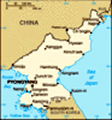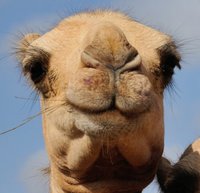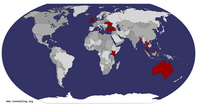COMING SOON HOUSE ADVERTISING ads_leader
After being awakened to many aspects of North Korea - the passionate pursuit of a military policy and panegyrics about the Great Leader being two examples - there were more revelations as we concluded our North Korean odyssey. One was the extremely proud nature of the North Korean people. This extended to a great pride about their history, and they make great efforts to preserve and display their historical sites. These places were always attended to by a local guide - most were women dressed in traditional flowing gowns in pastel colours, but sometimes they were men - including one who bore a striking resemblance to the Dear Leader.
Some of these sites were impressive, including the 14th century Tomb of Kongmin near Kaesong, where the 31st ruler of the Koryo dynasty is buried with his wife. Situated on a hill that overlooks a splendid valley, the view from this vantage on a late afternoon was beautiful as we looked across the peaceful valley as the last shafts of light cast a deep amber glow across the peaks.
Another favourite was the Pohyon Temple near Mt Myhongyang. Set in yet another gorgeous valley called the Sangwon - it was
a collection of disparate buildings, some dating back 600 years, but other reconstructed due their destruction by US imperialist aggressors during the Korean War. I would have loved to linger here for hours, but our Korean hosts were always rushing us between sites - and so one of travel’s greatest pleasures - quietly sitting in a shaded spot absorbing the ambience of a place - was repeatedly denied to me.
Souvenirs were sold at each location, and they consisted of books by the Great Leader, CDs of Korean music, traditional Korean dolls, and plenty of stamps. Foreigners could not use local currency, but instead were forced to use Euros or Chinese Yuan at ludicrously inflated prices. At one site, I witnessed a remarkable event when Fi decided not to purchase a booklet of stamps after hearing the price; at which time the softly spoken attendant replied with a cheaper price. In a country where the cost of every item is fixed by the government, this genteel haggling was a slither of capitalism intruding upon a command economy. In a market economy, an oversupply of stamps and undersupply of tourists would mean a reduction in price - but to witness
this practice in a command economy was astonishing to say the least.
There were many enduring memories from the country - the Great Leader, the military, our isolation - but the most surprising was North Korean’s passion for the arts - particularly music and dance. In a society where external forms of entertainment, such as computer games, television, or internet are rare or nonexistent - people turn to more traditional pastimes. I deduced that if North Korea is to be placated in the world arena, then it lies in closer cultural goals. An acceptance of the North Korean music and culture will go a long way to soothing the antagonism that nation displays to other countries. For example, when our Guide told us about the New York Philharmonic Orchestra's visit to Pyongyang in 2008, it was the only time I heard the US referred to with any warmth.
The pinnacle of artistic achievement is the Mass Gymnastics and Artistic Performance spectacle - known as
Arirang (the same word used for traditional folk songs). This is a 90 minute spectacular performed by 100,000 people, of which 90%!a(MISSING)re amateurs. Against a backdrop that constantly shifted as schoolchildren changed coloured
cards, the choreography and disciplined moves of the performers was mesmerising as it recounted the birth and rise of the North Korean nation. Our Guide wanted to know if it surpassed the Beijing Olympic Opening Ceremony, and we had to concede that it did not - Beijing’s show displayed a greater extravagance and a scintillating atmosphere. However,
Arirang was much more graceful; how all these performers synchronised their moves was nothing short of stunning - it was an exhibition of precision, poise and perfection. But this synchronisation subtly expressed the highly regarded belief in the collective effort; the individual and their hopes and dreams mean little in this society, for their greatest value is what they contribute to the collective good.
We saw another example of artistic talent at the embroidery factory in Pyongyang and it contained the most exquisite example of this art I have ever seen. As was usual, pictures of the Great Leader and Dear Leader hung in every room - and a tally showing the productive output of the factory in reaching its target in the “150 days of Supreme Effort” campaign was displayed. We saw similar tallies everywhere, especially on the streets in smaller
towns where output of agricultural produce was measured.
Arguably my highlight in North Korea was visiting the stupendous Mangyongdae Children’s Palace in Pyongyang. Of all the ideas the Great Leader conceived, this is perhaps his finest. Dedicated to the pursuit of excellence, this monumental building of marble enables children to excel in areas such as dance, music, calligraphy, embroidery, and even the game of
paduk (known as
go in Japan). To highlight the talent within this building, we witnessed a tremendous musical and dance concert. The tireless work these children had put into their chosen fields was nothing short of stunning - there are not many countries in the world countries where children would be so dedicated to their art.
Seeing the North Korean’s love of culture provided one of the strongest contradictions of this country - how can a nation so intent on pursuing a military agenda possess such a great reverence for the classical arts? Similar, one may say, to the Soviet Union, where the same society that produced Stalin also produced Shostakovich. This question still remains unanswered in my mind.
On our last full day in the country was visited the International Friendship Exhibition,
a massive building containing thousands of gifts bestowed upon Kim Il Song from around the world, thus demonstrating the universal love for the Great Leader. After placing cloth slippers over our shoes in order to preserve the immaculately glossy polished floors, we sampled only a glimpse of the 200 spacious rooms. The most profuse contributors being the Soviet Union and China - including a bullet-proof black limousine from Stalin.
We also toured the offerings for Kim Jong Il in a nearby building, a more humbling structure of 50 rooms. We were shown a photograph given to the Dear Leader by the former Foreign Minister of Australia, Alexander Downer. It was an image from the Opening Ceremony of the 2000 Sydney Olympics, where the two Koreas marched under one flag. I commented to the Official that I was at the Olympic Stadium that night, and when the Koreans emerged, one athlete from the south and one from the north both holding a blue and white flag depicting a united Korea, many people stood and cheered, and a loud applause erupted across the arena. The Official was truly surprised that Australians were so supportive of a peaceful Korean peninsula, and seemed
touched by my recollection of this event. The Official and local female guide continued to discuss my story, even asking me further questions and writing down my answers, perhaps for their own memory, or perhaps to inform future visitors that Australians also support a peaceful Korea. Either way, I am certain that their opinion of Australia increased by a noticeable degree. Just goes to show what a touch of validation can do for people of an ostracised nation.
We checked into a hotel for our last night - Pyongyang’s Pothoggang Hotel, run by a joint Japanese-North Korean consortium. I turned on the television and if my eyes did not deceive me, it was CNN! After seeing the BBC in the Yanggakdo Hotel, I thought that nothing more would surprise me - but unexpected surprises seem to know no end in North Korea.
The next morning we returned to the Pyongyang train station. In the daylight, it did not appear as gloomy as it did for our evening arrival nine days earlier, but it still wore an austere air. After an emotional farewell to our Driver, Guide and Official, we boarded the train, which soon rattled its way away from
the capital. Knowing that there was no Guide or Official to hinder my photography, I happily snapped at the countryside from the moving train - the joy of such a simple freedom! Because my camera would be checked at the border, I downloaded the photos into a folder on my netbook called “Goodbye” - this name chosen because if this folder was found, it was goodbye to my images!
Not long after deleting any suspect photos from my camera we pulled into the North Korean border town of Shinichi for the obligatory customs check. A horde of border officials boarded the train to search cameras and bags. Many people had photos deleted, including those images given approval by the Guide, and anything taken at the DMZ in Panmunjom was erased. In response to this, I deleted all DMZ photos from my memory cards before they were deleted for me.
The same pretty customs official I encountered on the inwards journey strode into my cabin to conduct the search. She remembered my two travel mascots, Lenny the Curious Lemur and Blu the Travel ‘Roo, for she immediately picked them up from their window location and said “These are your
friends” as I discerned a slight smile crossing her mouth. I quickly replied “Yes they are” in order to maximise this moment of levity. Her serious countenance quickly returned as she proceeded to check the photos on my memory cards, and not finding any offending images, handed it back to me. Things were going well so far, but it was about to change.
Upon looking at my customs declaration form which we were required to fill in, she noticed the word “Netbook” and asked me what it was. “A computer,” I replied. “A computer!?” was her startled retort, “What is on it?” “Nothing!” I immediately replied.
She looked at me and asked the question again in a more deliberate voice, “What is on it?”, this time emphasising every word.
I thought of all my images laying in wait on the netbook - those of the DMZ and from the moving train, but knew I had the confidence to carry this charade off, so I answered in a firm yet calm voice, “Nothing.”
As we looked directly into each other’s eyes in that awkward silence, I knew that the next few moments were either going to be
an exhilarating triumph or the whole situation was going to turn into an absolute shambles.
She paused and looked at me intently.
Finally, she uttered the word “Okay”, and after a cursory glance through my books, she moved onto the next person.
Despite having the only laptop and DSLR in my cabin of four people, I was the only person not to have their bags searched. In hindsight, lying to a North Korean customs official was fairly daft, but by using all the charm I could muster (and those of my mascots) I left the country with every one of my 2,000 photos intact.
After one hour of anxiously following the movements of this customs officer in case she decided to return, the train heaved forth as we chugged across the Yalu River into China. It was only upon arriving in China that I realised the latent pressure I had been harbouring whilst in North Korea. I suddenly felt relaxed and free, and was so excited at this revelation that I almost knelt and kissed the platform at the Dandong railway station. I had been so mindful to say the correct words, photograph acceptable subjects and
behave in a certain way that it had not occurred to me the stress associated with travelling, let alone living under such a regime.
After a holiday filled with unusual experiences, the final night’s journey to Beijing produced one more. The adjoining carriage was filled with an impromptu party of fellow adventurers into the hermit kingdom. It was here that a drunk Swedish tourist dressed in the olive uniform garb usually worn by the Dear Leader (a strange thing of itself), introduced me to a young communist-loving Japanese lad on his fifth journey to North Korea. He sat in the corner of a smoke-filled cabin playing cards with Chinese visitors, whilst playing revolutionary songs lauding the Dear Leader through the speaker on his iPhone. In a holiday filled with surreal experiences, this was perhaps the most surreal of them all.
COMING SOON HOUSE ADVERTISING ads_leader_blog_bottom
Tot: 0.084s; Tpl: 0.023s; cc: 13; qc: 25; dbt: 0.0319s; 1; m:domysql w:travelblog (10.17.0.13); sld: 1;
; mem: 1.2mb































Dor
non-member comment
Anxious Times at the Border
Hi Shane, anxious times at the border, also anxious times for us in Market Drayton. Deep down I wondered whether you may get yourself into some sort of pickle while there, but you somehow managed to charm again and wriggle out of it, and still managing to get some beautiful photos. I am glad you are not going anywhere like that anymore, it isn't good for my health! Like all explorers from the past it's there so you have to do it. This is another very exciting blog, thanks Shane, hope Lenny and Blue like all this travelling. Bye for now. Dor.